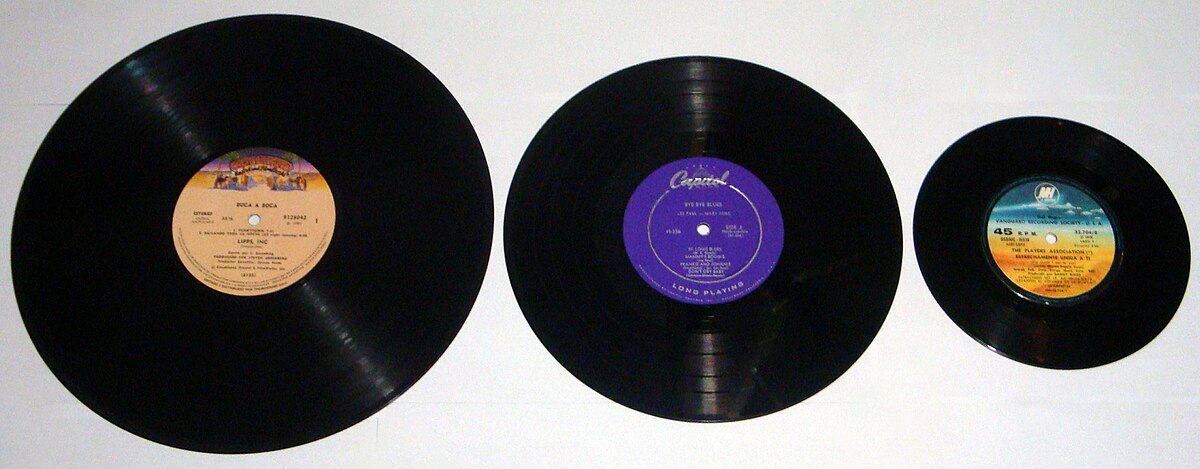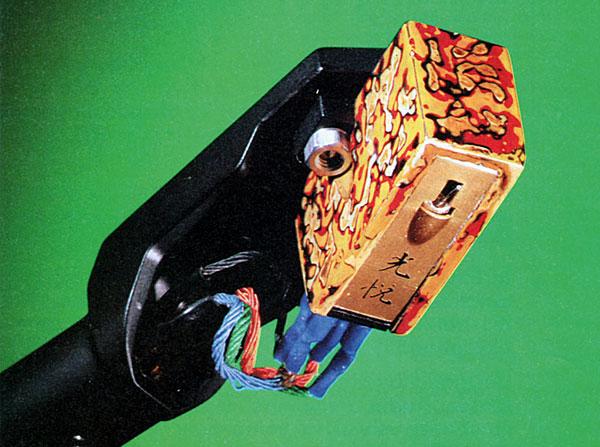Det fine med RIAA-bokser er muligheten til forskjellig lydopplevelse fra 1 platespiller bare ved å bruke en RCA-switch...Denne lenken går direkte til EQ-historien. And it's a bloody mess, helt fram til 1980-tallet:

Phonograph record - Wikipedia
en.wikipedia.org
trenger en pickup å være pen?
- Trådstarter rama
- Startdato
Diskusjonstråd Se tråd i gallerivisning
-
Så gammel?! Du kunne vært moren min!RIAA (Recording Industry Association of America) blev dannet i 1952 (året før jeg blev til)
Med ditt Nick bilde, ville jeg vært forsiktig med å spøke om din mor!Så gammel?! Du kunne vært moren min!
For å si det pent, det finnes pickuper som er penere!- Ble medlem
- 29.10.2016
- Innlegg
- 9.341
- Antall liker
- 24.210
- Sted
- Hjortshøj, Danmark.
- Torget vurderinger
- 2
Var ikke helt sikker på¨, om Tosken skulle ha eneller en
....... men da blev det en
.
Og du har helt rett @Hønndjevelen........
Me det selvportrettet i avatar´n ville jeg og være veldig forsiktig med å skryte av foreldrene mine......
Eneste positive må vel være, at de kan elske en TOSK

- Ble medlem
- 29.10.2016
- Innlegg
- 9.341
- Antall liker
- 24.210
- Sted
- Hjortshøj, Danmark.
- Torget vurderinger
- 2
Ser den...@Valentino, men det var noe annet enn avtastning med "stift".Denne lenken går direkte til EQ-historien. And it's a bloody mess, helt fram til 1980-tallet:

Phonograph record - Wikipedia
 en.wikipedia.org
en.wikipedia.org
In 1926 Joseph P. Maxwell and Henry C. Harrison from Bell Telephone Laboratories disclosed that the recording pattern of the Western Electric "rubber line" magnetic disc cutter had a constant velocity characteristic. This meant that as frequency increased in the treble, recording amplitude decreased. Conversely, in the bass as frequency decreased, recording amplitude increased. Therefore, it was necessary to attenuate the bass frequencies below about 250 Hz, altså nermest det motsatte av riaa, the bass turnover point, in the amplified microphone signal fed to the recording head. Otherwise, bass modulation became excessive and overcutting took place into the next record groove. When played back electrically with a magnetic pickup having a smooth response in the bass region, a complementary boost in amplitude at the bass turnover point was necessary. G. H. Miller in 1934 reported that when complementary boost at the turnover point was used in radio broadcasts of records, the reproduction was more realistic and many of the musical instruments stood out in their true formMerker det lett på album til utpå 60-tallet, at lyden er litt "sprø". Ofte er lydbildet man assosierer med 50-tallsmusikk mer et resultat av feil EQ enn at opptakene faktisk var sånn.Litt OT, men trådtittel minner meg litt om en Danmark reklame:
Man trenger ikke å ha en slem kone for å nyte en lille.
NEJ, men det HJELPER... ^ @HasseBasse Attenuering av lave frekvenser gjøres jo ved RIAA-kutting, nettopp på grunn av de store utslagene man ellers ville få ved lave frekvenser. Er ikke det liknende?
^ @HasseBasse Attenuering av lave frekvenser gjøres jo ved RIAA-kutting, nettopp på grunn av de store utslagene man ellers ville få ved lave frekvenser. Er ikke det liknende?
Ja du sier noe.Litt OT, men trådtittel minner meg litt om en Danmark reklame:
Man trenger ikke å ha en slem kone for å nyte en lille.
NEJ, men det HJELPER...
Jeg har jobbet i Danmark, og husker flere fine. Spesielt denne, som hang i kantina.
Beklager OT- Ble medlem
- 29.10.2016
- Innlegg
- 9.341
- Antall liker
- 24.210
- Sted
- Hjortshøj, Danmark.
- Torget vurderinger
- 2
Du har fuldstendig rett....... Det var min hjerne, som hadde gått på st.by.^ @HasseBasse Attenuering av lave frekvenser gjøres jo ved RIAA-kutting, nettopp på grunn av de store utslagene man ellers ville få ved lave frekvenser. Er ikke det liknende?
"Attenuate" er selvfølgelig å skru ned........ Hva skjedde??
Glad for å kunne bidra med klovneopptreden.
Det fjerner likevel ikke det faktum, at dette først var interessant, da magnetisk pickup/elektrisk forsterkning ble aktuellt.
En riaa/NAB/Decca/m.fl. encoded plate avspillt med "stift" er virkelig "en tynn kop the"Relativt anonym Hana SL her, men går veldig fint i takt med spilleren, både visuelt og lydmessig:
På en Dual? Er Hana-en "compliant" nok for det? Jeg ville trodd at den var litt for "tungdreven" for det, men dersom du er fornøyd, havner en Hana på lista mi for evt erstatning av gammel Shure
Only 3;years older then me and I quickly feel older.Så gammel?! Du kunne vært moren min!
Hana SL fungerer helt utrolig godt med Dualen (1219). Beste kombinasjonen jeg noensinne har hatt. Kjører 6Kohm inngangsimpedans på RIAAen - lyden er utrolig tight og oppløst. Jeg lytter på alt fra klassisk til rock, metall og hard electronica.På en Dual? Er Hana-en "compliant" nok for det? Jeg ville trodd at den var litt for "tungdreven" for det, men dersom du er fornøyd, havner en Hana på lista mi for evt erstatning av gammel Shure
Det minner meg på en scene i TV-serien "Star Trek Pickard" , der androiden Data lytter til musikk fra denne platespilleren:Får sånn sci-fi vibber av komboen pickup og headshell. Star Wars-estetikk, Blade Runner, slike ting.
Veldig kult.Vedlegg
-
654 KB Visninger: 91
- Ble medlem
- 29.10.2016
- Innlegg
- 9.341
- Antall liker
- 24.210
- Sted
- Hjortshøj, Danmark.
- Torget vurderinger
- 2
Det gør jeg så ikke...... nermest tvertimotOnly 3;years older then me and I quickly feel older.


Med denne kan du trygt sette på Morten Jørgensen og spekkhoggerne som fulgte etter danskebåten uten å røre spyet som rant fra ripa!Svaret på spørsmålet i trådtittelen kan være "Nei, men det hjelper." Er som med høyttalere, at man fort lytter med øynene.
Okay. Koetsu igjen.

Glem PUen , hva slags tonearmsledninger er det der ?Svaret på spørsmålet i trådtittelen kan være "Nei, men det hjelper." Er som med høyttalere, at man fort lytter med øynene.
Okay. Koetsu igjen.

Varför då då ?Kan se ut som individuelt isolerte enledere.
Men varför gjör dom på det här viset?
Det finnes jo kabelprodusenter som sverger til dette for signalets siste reis mot høyttalerene, bedre beskyttelse mot innstrålet støy. Men de tverrsnittene vi ser på bildet ditt må jo være i Nano-klasse.
Ser ut som litz wire. Har brukt en del kobberlitz for internkabel. Litt pes å avisolere men når de er loddet på så har de en utrolig bra mekanisk styrke og låter etter mine ører så bra som det skal.Kan se ut som individuelt isolerte enledere.
Men varför gör dom på det här viset?Audio Note har en med 3x0.05mm, jeg har terminert med en slik, det var ikke lett.
Audio Note 99.999% silver Tonearm wire | HIFICollective
Audio Note 99.999% silver Tonearm wirewww.hificollective.co.uk
Den på bildet har minst 5…
Loader du den med 6Kohm? Hana foreslår slev 400 Ohm.Hana SL fungerer helt utrolig godt med Dualen (1219). Beste kombinasjonen jeg noensinne har hatt. Kjører 6Kohm inngangsimpedans på RIAAen - lyden er utrolig tight og oppløst. Jeg lytter på alt fra klassisk til rock, metall og hard electronica.
Ja, men i mitt oppsett låter det for tynt. 6K viste seg å være innertier.Loader du den med 6Kohm? Hana foreslår slev 400 Ohm.- Ble medlem
- 20.08.2015
- Innlegg
- 18
- Antall liker
- 21
Jeg synes Goldring Legacy er en elegant pickup
At lyden også er i top gør bestemt heller ikke noget
Pparafinoksen
Gjest
Genialt, rett og slett.Gjetter min yngste datter ville valgt denne…
Vis vedlegget 802777 Vis vedlegget 802774 Vis vedlegget 802775 Vis vedlegget 802776Et annet estetisk uttrykk enn Koetsu o.l.,
men jeg synes Ortofon Verismo er stilig og pen.
Pen pris ogsåEt annet estetisk uttrykk enn Koetsu o.l.,
men jeg synes Ortofon Verismo er stilig og pen.
Vis vedlegget 812691 Vis vedlegget 812699
Er ikke for lavbudsjett, - ca60 store.Pen pris også
men er vel lavere priset enn f. eks. Koetsu over her. Jorwed selger nå nye Ortofon har jeg sett.
Georg Jensen lager noe lignende,den heter øllefant.
Georg Jensen skal vel borge for godt design?Georg Jensen lager noe lignende,den heter øllefant.
Jeg har en godt brukt øllefant, men den passer best til sitt bruk.
Dyr øljekk
CDON selger den for 979nkr (,øllefanten,)noe billigere enn den som kommer fra Nakskov!Dyr øljekk
Men fortsatt dyrt for en øljekk.Sist redigert: -
Laster inn…
Diskusjonstråd Se tråd i gallerivisning
-
-
Laster inn…







